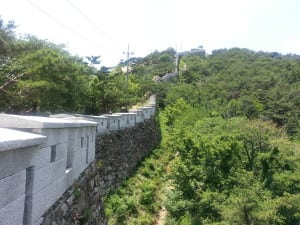 In the late 1300s, once the Chosun Dynasty was founded, work began in the new captial of Korea ( Seoul) which inlcuded the building of the inner and outer walls. The inner walls were built through the 4 major mountians surrounding Seoul, inlcuding Mt. Inwang. Because the wall foundations were very well built and because most of the wall was built through the mountains, much of it ( as evidenced by the picture of the wall on Mt. Inwang) still remains. In fact, the Seoul City inner wall, is the longest survivng wall of any major city in the world- relativley untouched by invasions and war. Whether a wall survives the test of time, depends on several factors. The same can be said for corporations. Corporations survive for the long term if the company is properly managed, if the business plan is updated with the times, if the product or service keeps up with demand and of course, if the risk management processes are robust enough to handle the numnerous areas of risk that the company will, most often than not, encounter.
In the late 1300s, once the Chosun Dynasty was founded, work began in the new captial of Korea ( Seoul) which inlcuded the building of the inner and outer walls. The inner walls were built through the 4 major mountians surrounding Seoul, inlcuding Mt. Inwang. Because the wall foundations were very well built and because most of the wall was built through the mountains, much of it ( as evidenced by the picture of the wall on Mt. Inwang) still remains. In fact, the Seoul City inner wall, is the longest survivng wall of any major city in the world- relativley untouched by invasions and war. Whether a wall survives the test of time, depends on several factors. The same can be said for corporations. Corporations survive for the long term if the company is properly managed, if the business plan is updated with the times, if the product or service keeps up with demand and of course, if the risk management processes are robust enough to handle the numnerous areas of risk that the company will, most often than not, encounter.
Have you looked at your risk management processes lately? How robust are they? How strong are they? Have they stood the test of time like the wall on Mt. Inhwang, or are they outdated like some of the processes used by investment banks in 2008?
When considering which processes to use or update, remember to conduct periodic risk assessments that monitor the effectiveness of the risk management processes. Only through a process of continuous risk assessments can a company effectively manage risk by identifying weaknesses in the system, which helps it to effectively maintain a robust risk management program.
What steps has your organization taken recently to conduct a comprehensive risk management program? Has it reviewed all critical corporate processes and procedures? When evaluating risk assessments in order to minimize risk, especially legal risk, specific goals or objectives should be established in which to judge the risk assessments that have been completed. What are the goals or objectives, if any, that have been established? When determining the objectives to evaluate risks, what specific processes or tools are in place to obtain those objectives? All of these questions must be answered.
Remember, legal risk management processes must be properly applied in order to provide risk management expertise and to prevent losses due to claims, litigation, investigations and fines. Such processes should include:
1. A periodic risk assessment of the company's operating divisions and departments,
2. The development of solutions to risk management issues,
3. Oversight of the company's outstanding claims and litigation,
4. Compliance review,
5. Training programs, and
6. Monitoring of compliance issues
Only with a proper implementation of a robust risk managment process can a company expect, with all things considered, to last like the Seoul City Wall on Mt. Inwang. Without it, the company like a wall , may come tumbling down.